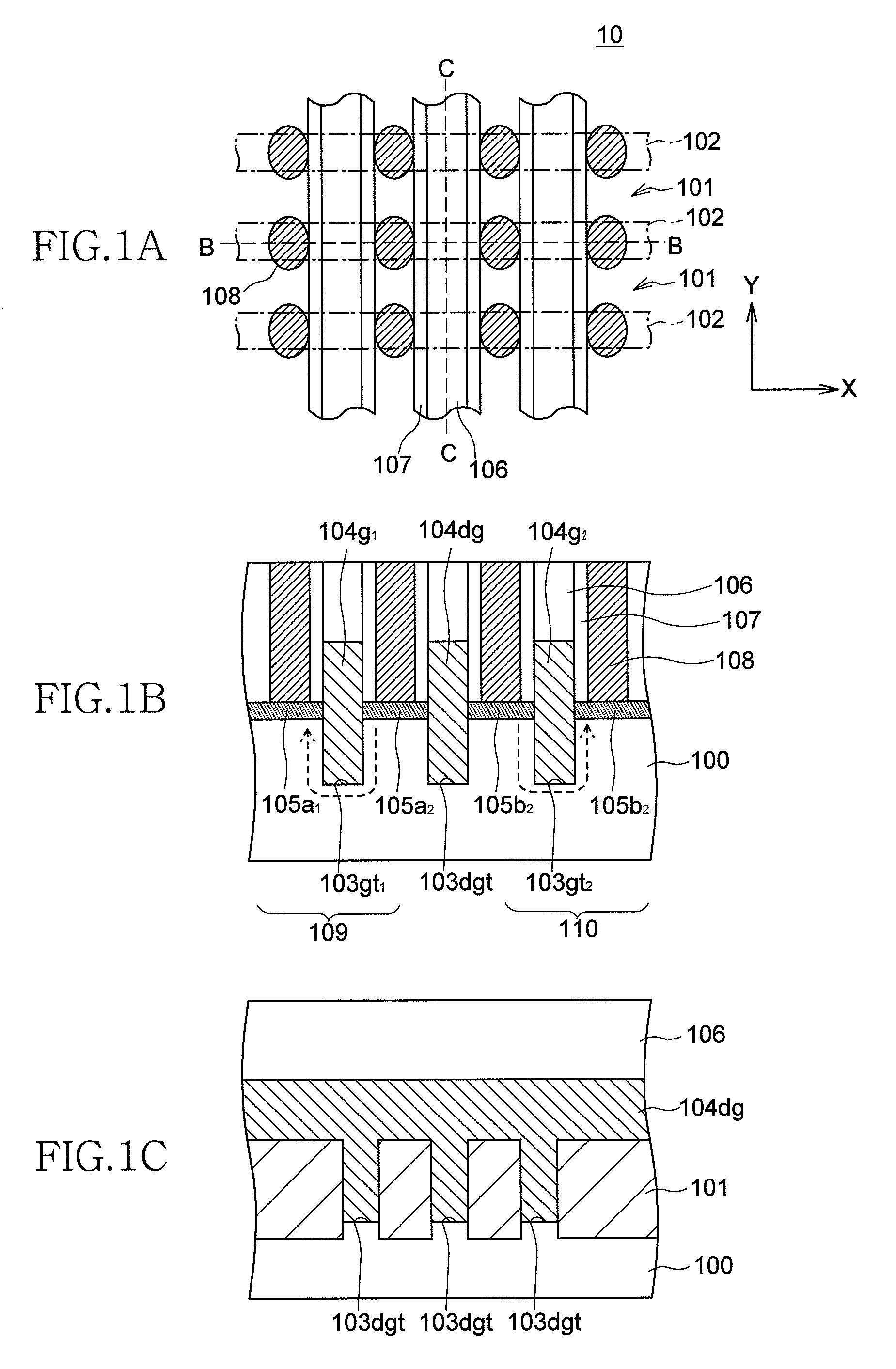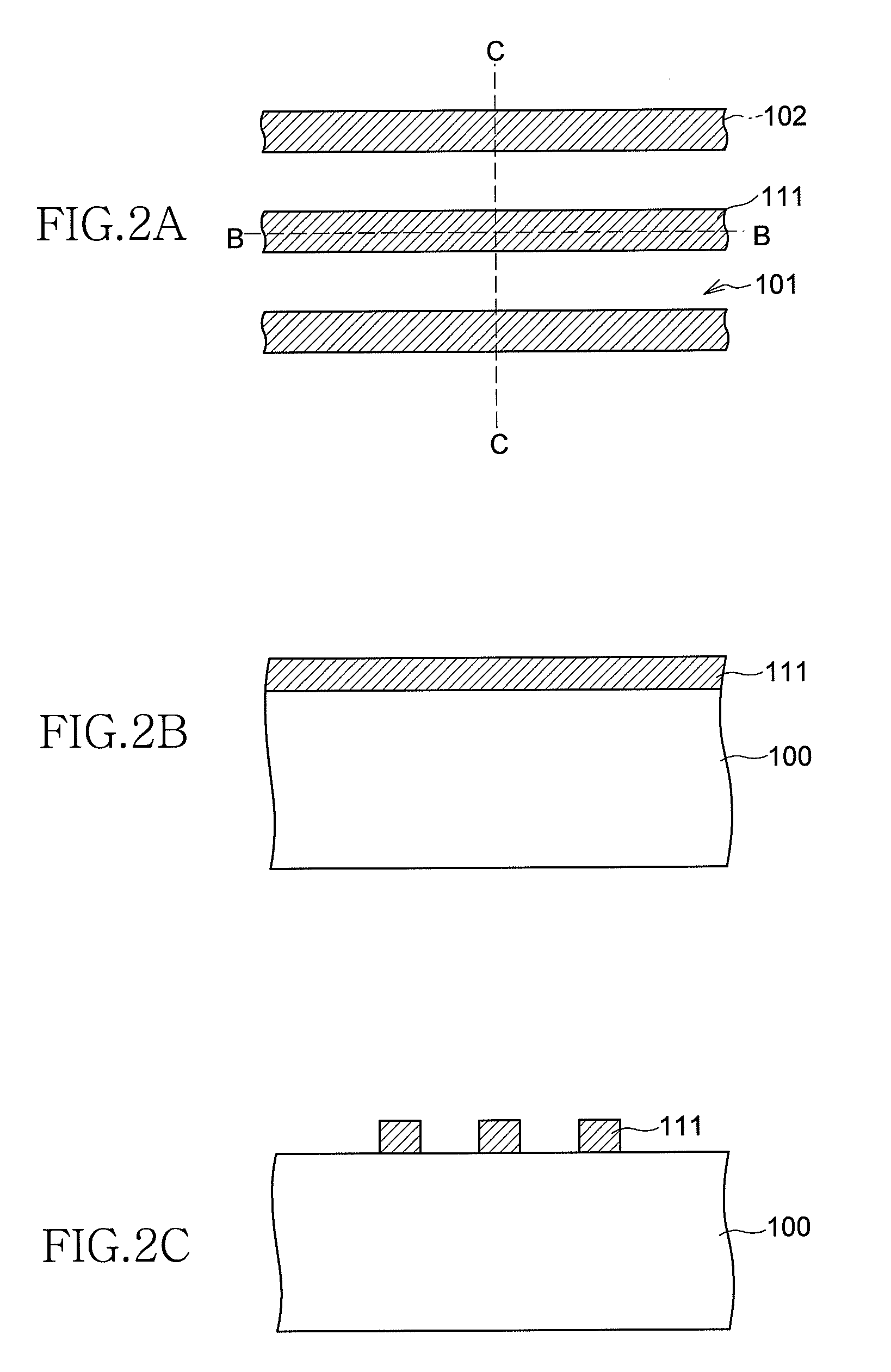Semiconductor device having gate trenches and manufacturing method thereof
a technology of semiconductor devices and gate trenches, which is applied in the direction of semiconductor devices, basic electric elements, electrical appliances, etc., can solve the problems of difficult to form fine patterns by photolithography and dry etching, limited photolithographic and dry etching targets, and significant increase in contact resistance, so as to prevent the reduction of active region patterns, suppress the reduction of diffusion layers, and easy to resolve
- Summary
- Abstract
- Description
- Claims
- Application Information
AI Technical Summary
Benefits of technology
Problems solved by technology
Method used
Image
Examples
first embodiment
[0045]As shown in FIGS. 1A to 1C, the semiconductor device 10 is configured to include active regions 102 provided in a semiconductor substrate 100, defined and divided by STI regions 101, and extending in an X direction (a first direction), first gate trenches 103gt1, second gate trenches 103gt2, and dummy gate trenches 103dgt provided in the active regions 102, and first gate electrodes 104g1, second gate electrodes 104g2, and dummy gate electrodes 104dg which extend in a Y direction (second direction) crossing the active regions 102, and at least a part of which are buried in the first gate trenches 103gt1, second gate trenches 103gt2, and dummy gate trenches 103dgt, respectively. Each of the dummy gate electrodes 104dg is arranged between one first gate electrode 104g1 and one second gate electrode 104g2.
[0046]First to fourth diffusion layers 105a1, 105a2, 105b1, and 105b2 to serve as source / drain regions are provided on both sides of the first and second gate electrodes 104g1 ...
second embodiment
[0058]As shown in FIG. 7D, the semiconductor device 20 includes fin portions 211 provided in lower portions of side surfaces of first and second gate trenches 203gt1 and 203gt2 in an X direction, formed by a part of a semiconductor substrate 200, and constituting a part of channel regions, respectively. Regions defined and divided by STI regions 201 and each indicated by a one-dot chain line are active regions 202. In a first transistor 209 and a second transistor 210, channel regions formed when a predetermined bias is applied to each of first and second gate electrodes 204gt1 and 204gt2 are formed not only on side surfaces and bottom surfaces of the first and second gate trenches 203gt1 and 203gt2 in a Y direction but also on the fin portions 211 provided on the side surfaces thereof in the X direction. By this arrangement, it is possible to reduce threshold voltages of the first and second transistors 209 and 210. Meanwhile, as shown in FIG. 7C, no fin portions are formed on sid...
third embodiment
[0074]A manufacturing method of the semiconductor device 30 is described next.
[0075]FIGS. 18A to 18D to FIGS. 25A to 25D show manufacturing processes of the manufacturing method of the semiconductor device 30 according to the third embodiment. In FIGS. 18A to 18D to FIGS. 25A to 25D, each drawing tagged as “A” is a schematic plan view, each drawing tagged as “B” is a schematic cross-sectional view taken along a line B-B of “A”, each drawing tagged as “C” is a schematic cross-sectional view taken along a line C-C of “A”, and each drawing tagged as “D” is a schematic cross-sectional view taken along a line D-D of “A”. When the schematic cross-sectional view taken along the line D-D is identical to that taken along the line C-C, the drawing tagged as “D” will be omitted.
[0076]First, as shown in FIGS. 19A to 19D, a first mask layer 313 having line-and-space patterns is formed on the semiconductor substrate 300. The region indicated by a one-dot chain line is to serve as the active regi...
PUM
 Login to View More
Login to View More Abstract
Description
Claims
Application Information
 Login to View More
Login to View More - R&D
- Intellectual Property
- Life Sciences
- Materials
- Tech Scout
- Unparalleled Data Quality
- Higher Quality Content
- 60% Fewer Hallucinations
Browse by: Latest US Patents, China's latest patents, Technical Efficacy Thesaurus, Application Domain, Technology Topic, Popular Technical Reports.
© 2025 PatSnap. All rights reserved.Legal|Privacy policy|Modern Slavery Act Transparency Statement|Sitemap|About US| Contact US: help@patsnap.com



